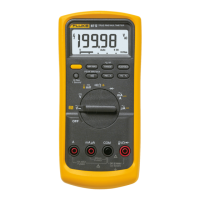Digital Multimeter
Precautions and Safety Information
3
• Do not apply more than the rated voltage, as marked on the
Meter, between the terminals or between any terminal and
earth ground.
• Never operate the Meter with the cover removed or the case
open.
• Use caution when working with voltages above 30 V ac rms,
42 V ac peak, or 60 V dc. These voltages pose a shock
hazard.
• Use only the replacement fuses specified in this manual.
• Use the proper terminals, function, and range for
measurements.
• Avoid working alone.
• When measuring current, turn off circuit power before
connecting the Meter in the circuit. Remember to place the
Meter in series with the circuit.
• When making electrical connections, connect the common
test lead before connecting the live test lead; when
disconnecting, disconnect the live test lead before
disconnecting the common test lead.
• Do not use the Meter if it operates abnormally. Protection
may be impaired. When in doubt, have the Meter serviced.
• Do not operate the Meter around explosive gas, vapor, or
dust.
• Use only a single 9 V battery, properly installed in the Meter
case, to power the Meter.
• When servicing the Meter, use only specified replacement
parts.
• When using probes, keep fingers behind the finger guards
on the probes.
• Do not use the Low Pass Filter option to verify the presence
of hazardous voltages. Voltages greater than what is
indicated may be present. Make a voltage measurement
without the filter to detect the possible presence of
hazardous voltage, then select the filter function.
XCaution
To avoid possible damage to the Meter or to the equipment
under test, follow these guidelines:
• Disconnect circuit power and discharge all high-voltage
capacitors before testing resistance, continuity, diodes, or
capacitance.
• Before measuring current, check the Meter's fuses.
See " Testing Fuses (F1 and F2) ”.

